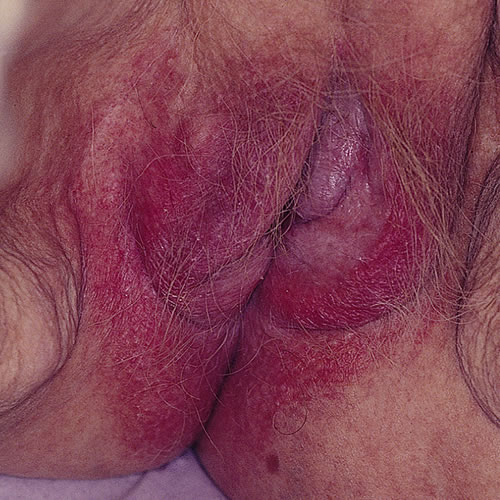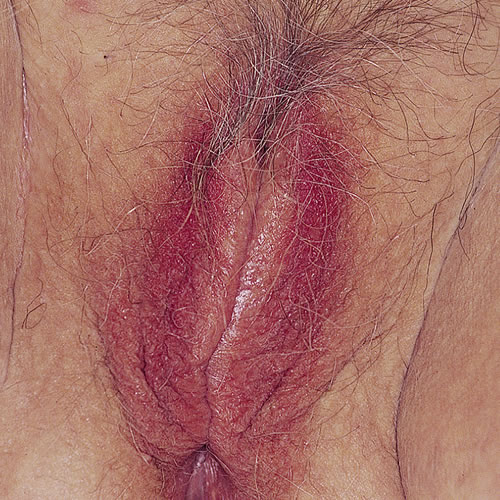Introduction
Topical steroids are extremely useful in the management of vulvar dermatoses and, if used correctly, are very safe.1 If, however, a potent steroid is applied incorrectly, or for prolonged periods, to keratinized skin (not the unkeratinized skin of the vestibule), changes may be observed. The skin changes have features in common with peri-oral dermatitis: a rosacea-like condition seen on the faces of young women who have been applying topical steroids to this area. For this reason, potent steroids on the face, as well as the thin and sensitive skin of the groin and anus are usually carefully restricted.
Epidemiology
Unknown
Etiology
Inappropriate application of a potent steroid to vulnerable areas such as the groin or anus may lead to rosacea. Sometimes, even with appropriate use of steroid ointments, rosacea can develop in epithelium adjacent to the steroid treatment site, for example on the labia majora when the labia minora are being treated.
Symptoms and clinical features
After several weeks of applying a topical steroid to the vulva, the affected area becomes red (erythematous). Small bumps (papules) and pustules, and wavy red lines appear intermittently. If there has been long-standing steroid use, broken capillaries (telangiectasia) may be seen. The changes may paradoxically be especially severe when the woman begins a taper or abrupt discontinuation of the topical steroid. Irritative symptoms of itching and burning often increase with the effort to discontinue the topical. Steroid rosacea occurs as a negative effect of the effort to treat another skin condition. Because of this, it is difficult to notice this situation as it gets worse because it is thought to be caused by the skin problem being treated. The patient often thinks that the steroid “is not working” or that she is dependent on it, and uses more. Understanding proper use of steroids in

Overview of treatment of vulvar skin disorders and pruritus.
Diagnosis
Diagnosis may be challenging. Irritant dermatitis manifested with erythema over the labia and external vulva may be confusing. The clinical history of steroid use and characteristic skin findings of rosacea with (and sometimes without) papules and granular-appearing erythema in the pattern of steroid application are diagnostic.

Pathology/laboratory findings
Biopsy is not necessary
Differential diagnosis
Contact dermatitis, tinea cruris, candidiasis, lichenoid dermatosis
Treatment/management
First, careful history is important. Is there urinary loss? Make sure that a pad designed for incontinence is used, and protect the vulva with a film of petrolatum or zinc oxide once or twice daily. Confirm that washing and toileting habits are not irritating. Stop any other topical treatments such as harsh soaps, scrubbing with a cloth, use of baby wipes (no matter how plain), or benzocaine product being applied. Then steroid application needs to be reviewed, eliciting where and how often steroid is applied. Many women are unsure of where steroid is to be applied and blindly put it on the labia majora. Some women do not understand how potent a very small dot of ointment is and how to spread it thinly. They think more is better.
Daily application of a potent steroid to the vestibule, periclitoral area and intralabial folds for 30-60 days is usually well tolerated and may be tolerated for ongoing treatment for severe dermatosis. Twice weekly application for maintenance, the standard when the dermatosis is well controlled, is usually tolerated without adverse side effects.2
Sometimes, even with correct application, the steroid may diffuse a few millimeters to involve the majora or groin. Review the placement and amount used; consider switching the patient to mometasone, a topical steroid with less penetration than the well known clobetatasol.
If the topical steroid is being applied properly and significant rosacea is present, consideration of discontinuation of the steroid may be necessary. If the patient has a dermatosis that requires ongoing treatment to prevent worsening of the condition, she may need weaning, then gradual reinstitution of the topical in an appropriate fashion.
To minimize severe flare-up, slow withdrawal is recommended by decreasing how often the product is applied and choosing a product that is less potent. If the patient is using a strong topical steroid class 1 such as clobetasol, she is weaned to a weaker class VI or VII steroid such as desonide. One approach for her is to alternate the potent with the mild steroid every other day for seven days, then use the substitute steroid daily for seven days, then twice weekly. Reevaluation is necessary at this point. It may be possible now to reintroduce the topical potent steroid on a once or twice weekly basis.
Non-steroidal topical medications are available for treatment of steroid rosacea; (Tacrolimus) Protopic .1% or .03% ointment and (Pimecrolimus) Elidel 1% cream. These two products are similar and are applied up to twice daily in place of the steroid.